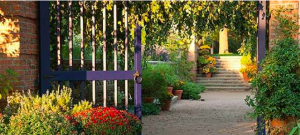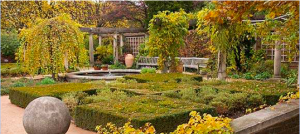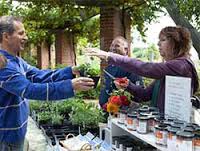I drove out to the Chicago Botanic Garden early one sunny morning in June for my third summer. Where would they ask me to volunteer this time?
Mary, who ran the Volunteer Office at that time, thought I might enjoy being a docent in the English Walled Garden. It was a good choice. I always enjoyed that garden when I went there on my own. The English Walled Garden is a very calm, peaceful and beautiful place. I would go there frequently, sit on one of the benches, and soak in the atmosphere.
Entering the English Walled Garden, from the Chicago Botanic Garden
Going to the English Walled Garden is like stepping back into the past when life was slower and people had more time for things like gardening. It’s like walking through a small rural village in England and peeking into everyone’s front yard to see what colorful plants they have growing. It could be 2004 or 1904.
John Brookes, an English landscape architect, designed the English Walled Garden in 1971 and he comes back periodically to consult with the staff and update it. It’s composed of six garden “rooms” open to the sky: The Checkerboard Garden, Cottage Garden, Daisy Garden, Formal Garden, Pergola Garden and the Vista Garden. Each room is different but all make you feel like you’re in England.
The Checkerboard Garden, from the Chicago Botanic Garden
That summer, lots of visitors came to the English Walled Garden. I enjoyed meeting them and showing them around. We had some interesting conversations. Frequently they would tell me that they were growing, or had tried to grow, this or that plant and how much nicer it looked here. They wanted to know what we did so they could try our techniques when they returned home.
Many visitors said the English Walled Garden gave them new ideas for what plants to plant in their own gardens when they got home. A number came from other countries. They had heard about the English Walled Garden from friends of theirs who had traveled to Chicago. Some were repeat visitors. They said that they came to the Chicago Botanical Garden, and the English Walled Garden in particular, whenever they came to Chicago.
Talking with all the visitors and hearing these comments made this one of my happiest summers volunteering.



